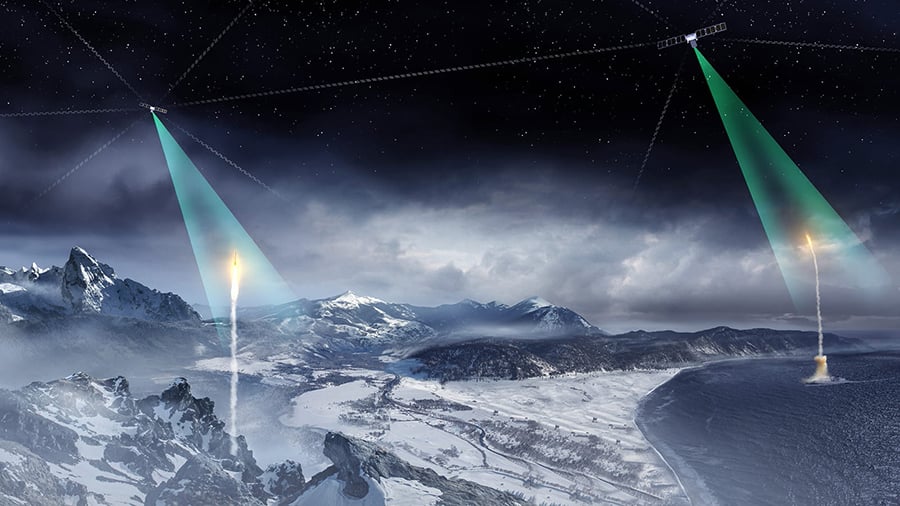
New capabilities like advanced data fusion engines can create a straight line for data to flow from IC satellites to ground-control stations to DoD warfighters in near-real time. (Graphic courtesy of Raytheon)
Evolving challenges affect the Intelligence Community (IC) and U.S. Space Force differently and often simultaneously. Developing novel Concepts of Operations provide opportunities for the agencies to partner more effectively.
An example of the intersection: tracking moving targets from space. This collaborative capability is urgently needed in light of the Air Force’s planned retirement of the E-8 Joint Surveillance Target Attack Radar System (JSTARS) and the DoD’s ever-expanding need to track ships around Taiwan and mobile rocket launchers in Crimea.
The challenge is not putting the physical Ground Moving Target Indicator (GMTI) sensors on satellites; it’s the coordination between the Department of Defense and the IC necessary to track surface movements in real-time and getting that data to tactical decision makers.
“This is a new type of capability,” said Chief of Space Operations Gen. Chance Saltzman in December. “It’s not completely the IC supporting the [DoD]. It’s not completely a DoD mission without the help of the IC. It’s this combination of the two.”
There’s also a third partner working on this task: industry. The connective tissue necessary to define new operational concepts and develop solutions is already in progress with companies like Raytheon, an RTX business. New capabilities such as advanced data fusion engines can create a straight line for data and intelligence to flow from IC satellites on orbit to ground-control stations to DoD warfighters in near-real time.
Stovepipes in space
The national defense community has been talking for years, decades even, about removing stovepipes that place boundaries around military services, networks, and data. Unfortunately, many remain, and they extend all the way to space.
Joint forces need access to advanced data architectures such as cloud computing for secure sharing of military and intelligence data. Increasingly, this data will come from on-orbit and ground-segment space architectures. These architectures include ground processing capabilities, transport layers, and infrastructures that enable the orchestration of federated resources like satellites. A significant challenge is figuring out the orchestration and joint Concept of Operations (CONOPs) between the DoD and the IC to achieve the high-precision custody of targets – knowing where an object is in any time and space – that is necessary to deliver lethal effects.
It’s harder than it sounds as the DoD is chartered under Title 10 of the United States Code to conduct military operations, while the IC is chartered under Title 50 to execute intelligence activities. Historically, the only way to task overhead systems to collect data for DoD missions is through Title 50 intelligence authorities. However, emerging needs for long-range kill chains need to use overhead systems as targeting sensors with fast and dynamic timelines nested in DoD’s battle management operations. A simple solution would be to build separate space architectures for DoD and IC needs but this would be prohibitively expensive.
For that reason, the DoD relies heavily on Title 50 assets and personnel for the collection, processing, and assessment of data it needs to conduct military operations. For the particular GMTI CONOPs and many others like it, we’re not talking about a few spy satellite photos from the president’s daily intelligence brief. Rather, it’s more akin to an MQ-9 Reaper providing real-time tracking at the edge to provide warfighters with the situational awareness they need to perform maneuvers, redirect fires, and maintain dominance.
“The DoD needs the Intelligence Community to be more responsive to their requirements because when you’re looking at engagements, kinetic engagements, the DoD will lead that fight but they need data,” said Jack Allen, Director of Mission Engineering at Raytheon. “Typically, data from intelligence resources that provided oversight and awareness of a battlefield wasn’t needed in real-time.”
“The demand, however, is to move intelligence assets to the edge to be closer to the air operations centers and command-and-control nodes being used by warfighters on the ground. They need that information on demand, and that’s the challenge today when we talk about orchestration.”

Interfaces for clean data exchange between the DoD and IC so the systems can talk to each other across security domains would position the Intelligence Community to better support the DoD. (Graphic courtesy of Raytheon)
Having proper interfaces for clean communication and data exchange between the DoD and IC, not only from a CONOPS policy level but also at the technical level so the systems can talk to each other across security domains, would position the Intelligence Community to better support DoD through better allocation of infrastructure assets.
“Even though the DoD has made advancements in joint warfare, the integration of space elements that don’t belong to Title 10 can still be improved,” noted Allen. “It would be something very useful in synergizing the effects that they need on the battlefield.”
Mission engineering for mission success
Raytheon is working with both the DoD and IC to make this orchestration a reality for the future force by evaluating architectures within specific scenario-based missions and providing quantitative outputs (i.e., measures and metrics) that can lead to greater mission success. The company focuses on simulating the behaviors and effects of executing the mission — the baseline and alternative mission approaches — amid potential variations in conditions to assess mission impacts.
To do this most effectively, Raytheon is following the Department of Defense Mission Engineering Guide, issued by the Office of the Under Secretary of Defense for Research and Engineering. It has essentially one main purpose: identifying and quantifying gaps and opportunities across missions and breaking down scenarios into their constituent components and assessing how their relationships affect the mission. It’s not a how-to guide, but rather describes a methodology that is scalable and adaptable in addressing questions related to mission scope, complexity, and time.
“We model our analyses after the DoD Mission Engineering concept, and I think that it will have a future within all of industry in providing insights to government,” said Allen.
“Raytheon takes a collaborative approach to deliver credible assessments on what our customers need, which helps them be more efficient with their dollars and provide the exact capabilities needed – not only from the strategic standpoint of the IC but also from what the tactical users want.”
When it comes to target custody at scale, resilient operations, adaptive systems, enabling mission growth, and innovation, Raytheon takes a disciplined mission-engineering approach to analyzing government missions, and comprehensively explains the key challenges and opportunities – backed up with data. Through architectural analysis, modeling and simulation tools, and expert knowledge, the company works to understand where the critical gaps reside and what it takes to close them.























